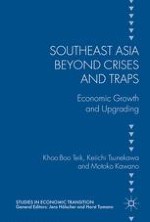2017 | OriginalPaper | Buchkapitel
2. New Growth Strategies of Thailand’s Big Firms in the ASEAN Economic Community Era
verfasst von : Akira Suehiro
Erschienen in: Southeast Asia beyond Crises and Traps
Aktivieren Sie unsere intelligente Suche, um passende Fachinhalte oder Patente zu finden.
Wählen Sie Textabschnitte aus um mit Künstlicher Intelligenz passenden Patente zu finden. powered by
Markieren Sie Textabschnitte, um KI-gestützt weitere passende Inhalte zu finden. powered by
